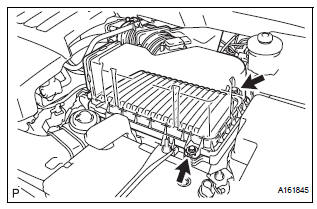Toyota Sienna Service Manual: Inspection
1. Inspect no. 3 Intake air control valve assembly

(A) inspect actuator operation.
(1) With 26.7 Kpa (200 mm hg, 7.9 In. Hg) of vacuum applied to the actuator, check that the actuator rod moves.
(2) One minute after applying the vacuum, check that the actuator rod does not return.
(3) If the operation is not as specified, replace the no. 3 Intake air control valve.
Installation
1. INSTALL NO. 3 INTAKE AIR CONTROL VALVE ASSEMBLY

(a) Engage the 2 claws and install the No. 3 intake air control valve assembly.
2. INSTALL AIR CLEANER CAP SUB-ASSEMBLY

(a) Install the air cleaner filter element, and air cleaner cap sub-assembly with the 2 bolts.
Torque: 5.0 N*m (50 kgf*cm, 44 in.*lbf)

(b) Connect the 3 vacuum hoses.
(c) Tighten the bolt, connect the 2 connectors, and install the 2 vacuum hoses.
3. INSTALL NO. 2 AIR CLEANER INLET (See page EM- 60)

 Removal
Removal
1. Remove no. 2 Air cleaner inlet (see page em-
28)
2. Remove air cleaner cap sub-assembly
(a) Disconnect the 3 vacuum hoses.
(b) Loosen the bolt, disconnect the 2 connectors, and
remove ...
 Vacuum tank
Vacuum tank
On-vehicle inspection
1. Inspect air cleaner cap sub-assembly
(A) check that air flows from port b to port a.
(B) apply 60 kpa (450 mm hg, 18 in. Hg) of vacuum to
port b. Check that there is ...
Other materials:
Installation
1. INSTALL SHOCK ABSORBER ASSEMBLY REAR LH
(a) Install the rear spring bumper No.1 LH to the shock
absorber assembly LH.
(b) Support the rear axle beam assembly with a jack.
(c) Install the rear shock absorber assembly rear LH,
cushion retainer and nut to the rear axle beam.
(d) ...
Installation
1. INSTALL SLIDE DOOR ROLLER ASSEMBLY UPPER
Apply MP grease to the rotating areas of the roller.
Install the roller with the 2 bolts.
Torque: 13 N*m (130 kgf*cm, 10 ft.*lbf)
2. INSTALL SLIDE DOOR HINGE ASSEMBLY CENTER LH
Apply MP grease to the rotating areas of the hinge.
In ...
No Communication in Immobiliser System
DTC B2796 No Communication in Immobiliser System
DTC B2798 Communication Malfunction No. 2
DESCRIPTION
These codes are stored in the memory when a key that does not have a
transponder chip is inserted or if
communication between the key and transponder key ECU is impossible.
DTC No ...
